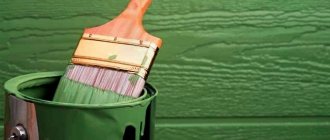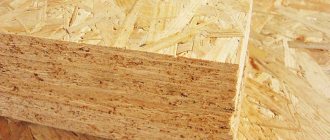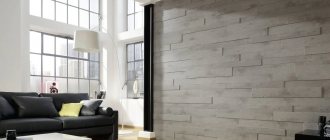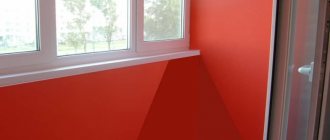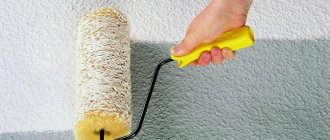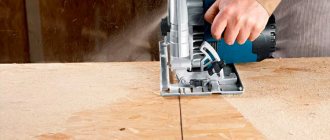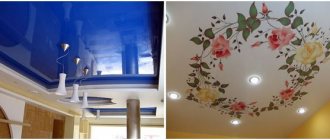Many owners of private houses choose paint and varnish materials for facade finishing.
Facade paints are characterized by increased resistance to negative influences, high strength, good adhesion and reliability.
It is these qualities that allow the material to be used for facade work.
There are situations when it becomes necessary to paint walls with such material, but not from the outside, but from the inside.
Is it worth doing this and what material to choose for this, it is better to understand in more detail.
What are the differences between facade paints and interior paints?
The first thing you should pay attention to is what exactly is the distinctive feature of materials that are designed to work outside and inside the house.
The list of differences is as follows:
- The main difference between these paints is that the materials developed for finishing facades have increased performance properties . This is due to the need to delay various negative factors that destroy the coating and walls of the house;
- for façade materials, a prerequisite is the ability to reliably provide protection to the entire house;
- With regards to color, the pigment of such compositions is much richer and has increased resistance to fading.
Facade paint, given its composition, which is designed for more severe and aggressive conditions, is not always completely environmentally friendly . However, the fact that the facade covering is used outside the house, this feature does not matter much.
Based on the above, it can be understood that paint for interior work will not have such qualities, and, therefore, such an aggressive composition. These materials do not need to be resistant to the negative effects of atmospheric factors. But there are high requirements for the drying speed of materials and the absence of unpleasant odors.
IMPORTANT!
The main condition for paint for interior work is a high level of environmental friendliness; at the same time, there are paints for facades that are allowed for interior decoration.
Types and characteristics
Paint and varnish materials for facade finishing are produced in various types, which are characterized by a special composition and properties:
- The silicate type is produced on the basis of liquid glass , which contains organic additives and hardeners. It is intended for painting limestone surfaces, houses made of aerated blocks, bricks and foam blocks. The material is characterized by resistance to atmospheric conditions, a high degree of air and vapor permeability, and non-flammability . Over time, such paint may lose color saturation, and the degree of adhesion to the base coating is initially low.
- The oil type is mainly used for painting wooden surfaces . It contains drying oils of artificial origin and a coloring pigment. With its help, you can protect the wooden surface from moisture and prevent putrefactive processes. After covering with oil paint, the surface stops breathing and the paint takes a long time to dry . It cannot be used on alkaline surfaces, since in combination with them it changes color, cracks and falls off. This type of paint does not have a high degree of durability.
- Enamel paints are used for wooden houses and metal elements . They are divided into alkyd and polyurethane. The first is characterized by the formation of a dense, strong, durable structure, however, it is very fragile. The second type is no less durable and additionally has elastic properties, is not susceptible to mechanical stress, and forms a glossy surface. It, like the previous one, cannot be used on an alkaline surface.
- The water-based type is made on the basis of various substances and can be polyvinyl acetate, butadiene styrene, acrylic, silicone and vinyl. PVC-based paints are characterized by a low level of resistance to moisture. They are not used for painting facades. The butadiene styrene variety is highly susceptible to fading after exposure to UV rays . Despite the fact that such paints are produced for facade work, it is not recommended to use this material for the exterior finishing process. For what purpose does the acrylic variety meet all the necessary requirements for façade paints, but cannot be used on a lime surface.
Painting instructions
It is worth applying façade paint in compliance with the temperature regime (+10...+30 degrees), in the absence of rain, fog, snow and wind. If it must first be diluted, then prepare water or water-based paint. Each container indicates the required mixture for this. Old cladding must be removed from the surface, cracks and irregularities smoothed out. If mold is present, remove it, rinse with water and dry. Apply the antifungal mixture in two layers, 6-8 hours apart. The best time for façade cladding is the end of May or the beginning of September.
Tools for work
Exterior paint requires the following construction kit:
- nap roller and brushes;
- empty clean container;
- ladder or stepladder;
- masking tape, tray, film for covering window and door openings;
- gloves;
- spray;
- solvent.
Please note: Alkyd paint for metal painting
Many craftsmen stretch the film half a meter from the wall to protect it from dust. In the absence of wind and pets, this is not necessary.
Rollers and brushes
Masking tape
Ladder
Surface preparation
Well-executed preliminary preparation of walls guarantees a good result. Before starting work, you should look at the weather forecast for the next 3 days. There should be no precipitation, strong winds or low temperatures. Seal door and window openings with film. Do the following:
- If the walls have been painted previously, remove the old paint and sand them well.
- Remove all visible surface irregularities, clean and level it as much as possible with plaster. Wash off the dust with water and let dry.
- Treat with a primer with protection against fungus and a high penetration class.
Next, façade paint is applied on plaster for exterior use.
After removing the old coating, it is necessary to prime the surface
Painting process
Painting the facade is easier with a paint sprayer, but if you don’t have one, you can use a lint roller or a soft, wide brush. Step by step execution:
- The coloring mixture is stirred.
- It is applied to the surface in three directions: vertically, horizontally and diagonally. With this technique, all the cracks are filled and the layer is uniform.
- Painting is carried out in 2 layers without long breaks between them, lime in 3. The next layer is applied only after the previous one has completely dried.
- All walls must be painted on the same day, otherwise joints and borders will be visible.
After finishing the work, the walls are covered with plastic film from precipitation and dust. Only when the paint is completely dry does it gain its declared properties. This is worth considering.
Spray painting process
Can façade paint be used indoors?
Facade types of paint are used only with a composition that meets the requirements for interior work.
These include:
- Binders . Silicone and acrylic varieties are suitable for this component of paint. Synthetic resin is used for their production, which gives them good quality and high performance characteristics.
- Waterproof level . This indicator should be maximum, since the surface also needs protection indoors. This is especially important if finishing is carried out in the bathroom, kitchen or sauna.
- Wear resistance . Regarding this parameter, the best option is to use the acrylic variety . After application, it creates a high-density layer, which is characterized by resistance to any kind of influence, even mechanical. This allows the coating to provide an attractive appearance for a long time.
The paints and varnishes offered on the market have a fairly high drying speed, however, this point should be clarified before purchasing.
NOTE!
Facade paint can be used for interior work, but not all types are suitable for this.
Considering the above, we can identify some types of facade paint that are suitable for interior work:
- Silicone . This variety belongs to the organosoluble variety, the composition of which is based on silicone. It can be applied to plaster wall, brick walls or concrete surface. There are no substances in the composition that can evaporate toxic substances . Some manufacturers produce a variety of this paint that is suitable even for painting children's rooms.
- Acrylic also belongs to the class of solvent-soluble and has a high drying rate . Considering that it was developed specifically for use in non-standard climatic conditions, its composition is capable of providing protective properties to the surface and making it resistant to negative external influences.
- A water-based variety of acrylic paint . The composition contains fungicidal additives that provide the coating with a protective layer that is resistant to various types of biological damage. It is characterized by the formation of a high-strength polymer film. It does not react to external influences and retains its properties for a long time.
Classification of coatings
Liquid glass serves as the basis for all silicate coatings. The coloring composition contains natural elements and belongs to the group of mineral coatings. Among the significant advantages are:
- Resistant to sunlight.
- Resistance to temperature changes.
- Invulnerability to natural phenomena.
- Breathability.
- Biological stability and durability.
Negative indicators include the toxicity of raw materials and the need to use protective equipment during work. Facade silicate coatings are not washed off and do not have mechanical stability. They cannot be combined with paint and varnish coatings.
Slaked lime serves as the main element of lime paints. This material is highly breathable and resistant to mold. It is available to most consumers due to its minimal cost. Among the disadvantages are instability to atmospheric conditions and a minimum number of colors.
The main substance of acrylic paint for facades is resin. Acrylic paints for facade work are presented in a rich color scheme and are in great demand when decorating facades. Like any other material, acrylic has its advantages and disadvantages. Positive characteristics include a rich range of colors, resistance to wear and mechanical stress, and elasticity. A flaw can be considered low air flow.
Silicone-based raw materials have the structure of an aqueous emulsion. Silicone paints perfectly repel natural precipitation and do not absorb dirt from the environment. In addition, they allow air to pass through perfectly and are not damaged by mechanical stress or changes in temperature. They do not fade or deform from exposure to the sun, and do not collect street dust.
READ MORE: Wind generator for a private home
